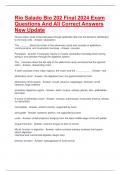Exam (elaborations)
Rio Salado Bio 202 Final 2024 Exam Questions And All Correct Answers New Update
- Course
- Institution
Rio Salado Bio 202 Final 2024 Exam Questions And All Correct Answers New Update Occurs when small molecules pass through epithelial cells into the blood for distribution to the body cells - Answer -absorption The _______ abuts the lumen of the alimentary canal and consists of epithelium, Lami...
[Show more]



